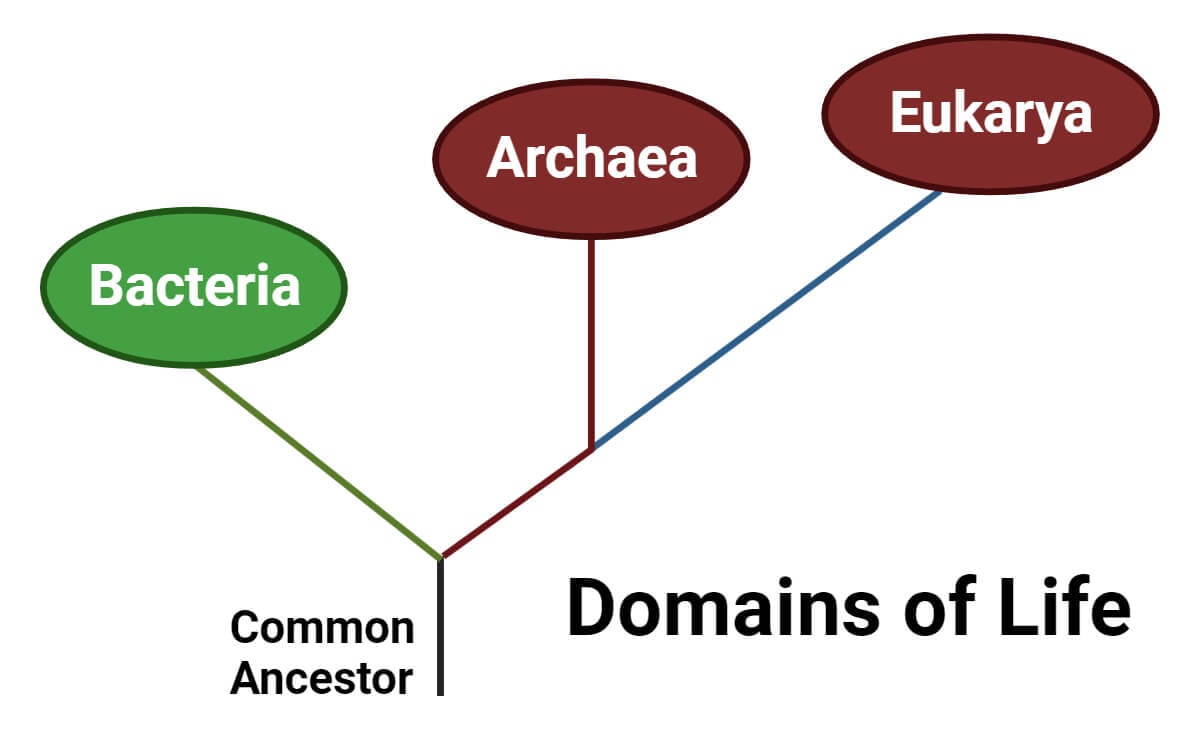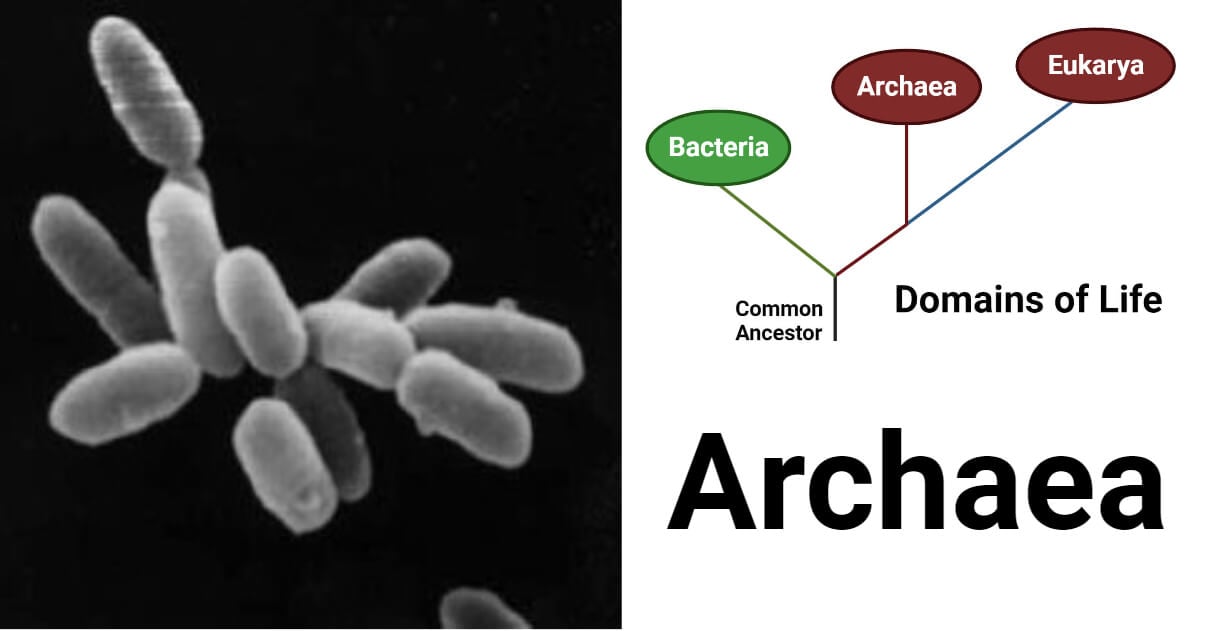Archaea is a domain of life, together with Bacteria and Eukarya, containing single-celled prokaryotes other than bacteria. They are the oldest life-form known to exist.
The name Archaea is derived from the Greek word ‘ARCHAIOS’ meaning primitive. They show primitive living characteristics like simple structure, simple mode of nutrition acquisition and biochemistry, and extreme habitat.

Initially, under the two-kingdom system, Archaea were considered as types of bacteria and were included in the ‘Prokaryota’ domain and were known by the name Archaebacteria. However, biochemical and genetic studies reveal that Archaea have different metabolic characteristics and genetic constituents than that of Bacteria. In 1977, Carl Woese and George E. Fox first suggested Archaea be different from bacteria based on their rRNA gene analysis and suggested they be different domains of life.
Archaea are microscopic, single-celled organisms lacking nuclei and other membrane-bound organelles like bacteria. Structurally they are similar to bacteria in their shape and size – microscopic with an average size of 0.1 to 15 μm, coccoid, oval, or bacillus. However, some species are flattened and square (like Haloquadratum walsbyi) and may reach up to about 200 μm or more. Like bacteria, Archaea are also aerobic, anaerobic, or facultative. Due to such structural resemblance, they were initially thought of as bacteria and were defined as Archaebacteria.
Additional to these bacterial characteristics, Archaea also possesses characteristics of Eukaryotes. They show some genetic and metabolic characteristics similar to those of Eukaryotes.
Interesting Science Videos
Habitat of Archaea
Initially, they were reported to present only in extreme habitats; however, after the development and use of culture-independent techniques, it is revealed that Archaea are ubiquitous in nature.
They define the extreme possible habitat where life-form can survive and thrive. Diverse Archaea genera are found to thrive in extreme places like hypersaline, hyper acidic, anaerobic, and extreme temperature conditions like hydrothermal vents and hot water springs. Some genera of such extreme places can be cultured in a lab using a culture medium, but most of the genera, both found in extreme and normal habitats, can’t be cultured.
It is estimated that about 20% of ocean microflora is occupied by Archaea. Even in extreme saline conditions like salt and soda lakes, abundant halophilic species of Archaea like Halobacterium spp., Haloquadratum spp., Natronomonas spp., etc. are found.
Thermophilic Archaea are found in hydrothermal vents, hot water springs, and volcanic areas. Pyrococcus furiosus, Thermococcus kodakarnesis, Pyrolobus fumarii, Methanopyrus kandleri, etc. are able to thrive even in temperatures at or above 100oC. In contrast to these, several species are extreme psychrophiles and survive even freezing temperatures (some can even survive at -10 to -20oC) of Antarctic lakes, Artic oceans, Polar Ice Sea, etc. Halorubrum lacusprofundi, Haloarcula spp., Psychromonas ingrahamii, Methanogenium spp., etc. are reported in such extremely cold places.
Acidic conditions with pH 0 are also suitable places to grow for species like Picrophilus torridus. Extreme alkaline condition with pH 11 or more is also no obstacle to the survival of Archaea like Natronobacterium spp., Alkaliphilus spp., Natronorubrum spp., etc.
Distinguishing Characteristics of Archaea
Archaea exhibit some distinguishing molecular and physiological characteristics which support their division as a separate domain of life. Some distinguishing characteristics of Archaea are:
1. Cell Wall
Archaeal cell walls lack peptidoglycan, the major component of bacterial cell walls. Cell walls of different Archaea are chemically composed of different materials, mainly of different polysaccharides and glycoconjugates.
Some methanogens contain pseudo polysaccharides (pseudo murein) in their cell wall. Though the pseudo polysaccharides are structurally similar to the bacterial polysaccharide, they are chemically different – lack D-amino acids and N-acetylmuramic acid.

2. Cell Membrane and Specialized Membrane Proteins
The cytoplasmic membrane of Archaea is different than Eukarya and Bacteria. Their cell membrane is composed of glycerol-ether lipids, unlike glycerol-ester lipids of other domains.
The phospholipid backbone of the Archaeal cell membrane is stereochemically different than those of Eukarya and Bacteria. They have sn-glycerol-1-phosphate backbone whereas others have sn-glycerol-3-phosphate.
Fatty acids in the membranes are also structurally different in the sense that Archaeal membrane fatty acids are long isoprenoid and highly branched with multiple side-chains and some also contain rings of cyclopropane or cyclohexane in contrast to Bacterial and Eukaryotic membrane fatty acids which are straight without branching and rings. The membranes also house specialized proteins like rhodopsins that function in capturing light and generation of a proton gradient.
3. Genetics
Genomes of Archaea have unique genes which code for proteins characteristic to them only. Their rRNA sequence and tRNA genes are also unique in many ways. Some Archaeal genes may contain introns. Horizontal gene transfer is common in many Archaeal genera.
4. The complexity of RNA Polymerase
RNA polymerases of Archaea are different and complex. They are more closely related to those of eukaryotic RNA polymerase.
5. Metabolism
Different species of Archaea are capable of methanogenesis. Methanogenesis is the process of production of methane gas during metabolism, and it is seen only in Archaea. Besides, they are capable of chemolithotrophy, photoautotrophy, and hyperthermophilic growth.
6. Extreme Habitat
Archaea colonize several extreme habitats including hyper-saline places, hyper-acidic and basic places, and extreme cold and extremely hot places where other life forms can’t even survive.
Classification of Archaea
Based on the phylogenetic relationship, Archaea are classified into different phyla some of which are well recognized and some are recently discovered and still proposed phyla. Some of them are introduced below:
1. Euryarchaeota
It is a well-recognized and the largest phylum of Archaea containing diverse genera that can survive in extremely alkaline, extremely saline, and extreme thermophilic conditions. Several methanogens are also grouped under this phylum. Though initially Euryarchaeota were thought to be extremophiles only, several genera were isolated from a normal environment like water springs, soil, water, rhizosphere, intestines, etc.
2. Thermoproteota
Previously known as Crenarchaeota, includes the most abundant marine Archaea, most of which are sulfur-dependent thermophiles and extreme thermophiles.
3. Nitrososphaerota
It is a proposed phylum that includes Cenarchaeum symbiosum and three species of Nitrosopumilus genus which were originally classified as a member of Thermoproteota phylum. The rRNA gene sequence and topoisomerase enzyme were found different than other members of the Thermoproteota phylum in these species; hence this phylum was proposed in 2008.
4. Nanoarchaeota
It is one recently proposed phylum containing Nanoarchaeum equitans as well-recognized culturable species and other proposed genera.
5. Korarchaeota
Also known as Xenarchaeota, Korarchaeota is a deep branching lineage of Archaea having different rRNA sequences and protein sequences than other phylum. It is revealed that they possess characters of both phyla, Euryarchaeota and Thermoproteota.
6. Aigarchaeota
It is a proposed phylum containing a well-recognized member Caldiarchaeum subterraneum. But, this phylum is still debatable and not accepted because its characters are similar to those of members of Nitrososphaerota.
Ecological Significances of Archaea
Archaea are a diverse group of microorganisms ubiquitously found on the Earth, even in extreme environmental conditions. They play significant ecological roles such as:
1. Methanogenesis
Archaea are the only known life forms to metabolically produce methane gas in the natural environment.
2. Nutrient cycling in extreme habitats
Archaea can thrive in several extreme places and they place an important role in maintaining nutrient cycles of such extreme places where other producers, consumers, and decomposers can’t survive. They gradually make such extreme places rich in organic matter and useable inorganic minerals and eventually help in the establishment of a diverse ecosystem.
3. Biogeochemical Cycling
Archaea are abundantly found in almost every region of the Earth’s surface where they actively take part in the nitrogen cycle, carbon cycle, sulfur cycle, and other biogeochemical cycles.
4. Symbiotic Relationship
Archaea are found to be symbiotically associated with the roots of plants, coral reefs, and even the intestine of animals.
5. Maintenance of Marine Ecosystem
It is estimated that about 20% of marine microflora is composed of Archaea. They place important roles in maintaining biogeochemical cycles, production of organic matter, and decomposition in marine environments.
Human Applications of Archaea
Scientists have been researching several Archaeal genera and have devised several uses for them for our and environmental benefits. Some common applications of Archaea are listed below:
- Enzymes of extremophiles are used in several industrial applications like food processing, detergent production, leather processing, thermophilic enzymes, etc.
- They are used in the production of biogas (methane gas).
- Bioremediation is another important use. Several Archaea are used to remove harmful chemical wastes, metals (bioleaching), and pollutants from contaminated environments.
- Archaea are also used in fermentation processes for the production of cheese and some fermented foods. They are also used as probiotics.
- Several biorefinery processes involving the production of amino acids, enzymes, biofuels, etc. are under study.
- Some Archaea are found to produce polyhydroxyalkanoates (PHAs) which can be used to make bio-plastic.
Archaea vs. Bacteria vs. Eukarya
| Character | Archaea | Bacteria | Eukarya |
| Cell Type | Prokaryotic | Prokaryotic | Eukaryotic |
| Habitat/Ecology | Often extreme environments as well as normal | Often normal and rarely in extreme environment | Diverse normal/moderate environment |
| Cellular Organization | Unicellular | Unicellular | Unicellular as well as Multicellular |
| Cell Organelles | No membrane bound cell organelles | No membrane bound cell organelles | Membrane bound cell organelles present |
| Cell Wall Composition | Pseudopeptidoglycan, different polysaccharides, and glycoconjugates | Peptidoglycan | Cellulose, hemicellulose, and different polysaccharides and chitin |
| Cell Membrane Composition | Contains ether-linked lipids and branched side-chains Contain sn-glycerol-1-phosphate backbone | Contains ester-linked lipids and unbranched side-chains Contain sn-glycerol-3-phosphate backbone | Contains ester-linked lipids and unbranched side-chains Contain sn-glycerol-3-phosphate backbone |
| Horizontal Gene Transfer | Present in many species | Present in some species | Occur in some, but is a rare phenomenon |
| Histone and Histone-like Proteins | Histone-like protein present | Absent | Presence of histone protein |
| Introns | Present | Absent | Present |
| Ribosomal RNA (rRNA) | Distinct rRNA sequence | Distinct rRNA sequence | Distinct rRNA sequence |
| Mode of Reproduction | Mostly asexual (fission) | Mostly asexual (fission) | Sexual and Asexual |
| RNA Polymerases | Multiple and complex RNA Polymerases | Single RNA Polymerase | Multiple and complex RNA Polymerases |
| Methanogenesis | Present | Absent | Absent |
References
- Esko JD, Doering TL, Raetz CRH. Eubacteria and Archaea. In: Varki A, Cummings RD, Esko JD, et al., editors. Essentials of Glycobiology. 2nd edition. Cold Spring Harbor (NY): Cold Spring Harbor Laboratory Press; 2009. Chapter 20. Available from: https://www.ncbi.nlm.nih.gov/books/NBK1945/
- Woese CR, Magrum LJ, Fox GE. Archaebacteria. J Mol Evol. 1978 Aug 2;11(3):245-51. doi: 10.1007/BF01734485. PMID: 691075.
- Dunlap, P. V. (2001). Microbial Diversity. Encyclopedia of Biodiversity, 191-205. https://doi.org/10.1016/B0-12-226865-2/00197-8
- Niederberger, Thomas. “archaea”. Encyclopedia Britannica, 20 May. 2023, https://www.britannica.com/science/archaea. Accessed 9 August 2023.
- Archaea. (2023, August 7). In Wikipedia. https://en.wikipedia.org/wiki/Archaea
- https://study.com/academy/lesson/archaebacteria-definition-examples.html
- https://byjus.com/biology/archaebacteria/
- https://www.sciencedirect.com/topics/earth-and-planetary-sciences/archaebacteria
- https://biologydictionary.net/archaebacteria/
- https://www.geeksforgeeks.org/archaebacteria/
- https://www.scientificamerican.com/article/archaebacteria-the-third/
- https://www.vedantu.com/biology/archaebacteria
- https://ucmp.berkeley.edu/archaea/archaea.html
- https://microbiologynote.com/archaebacteria-definition-types-characteristics-structure-examples/
- https://biologywise.com/characteristics-of-archaebacteria
